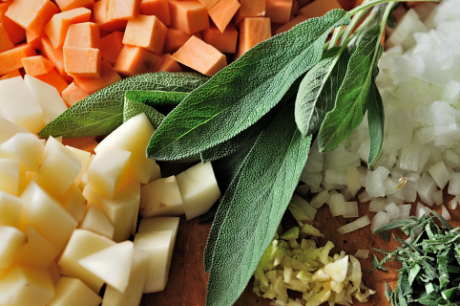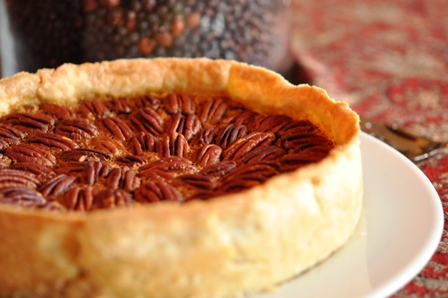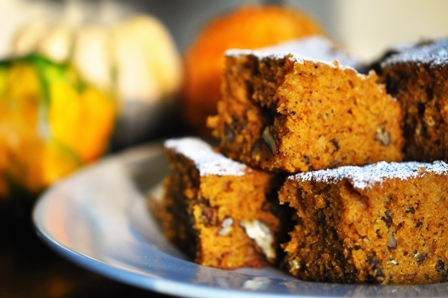
As a chilly November rain fell yesterday, I decided it was a good day to stay home and forage for ingredients “in house” for our supper. While rummaging around in the potato/onion bin in the garage, I found a few home grown sweet and white potatoes a friend had dropped off. I’d also just been poking around at the sage in my herb patch, wondering if I would be able to use it up before the big winter frost. And that, my friends, is how we came to dine on sweet potato chowder with browned butter and crispy sage leaves. The freshly dug potatoes were so velvety smooth and sweet. It wasn’t much work to make the soup taste fabulous. As for the fresh sage, herbalist and chef Jerry Traunfeld of the Herbfarm in Woodinville, Washington thinks that it has a much better flavor if cooked first in a fat before added to a dish and I heartily agree. I just adore sage when it is fried in a little butter (or a lot) and it makes for a lovely garnish as well. But, what to do with the remaining sage flavored browned butter? So simple yet delicious, it would be a crime not to just drizzle it over this plush chowder.
Kitchen Counter Point: One of the basic skills taught in cooking school is how to season soups and sauces. The usual suspects such as kosher salt and freshly ground black pepper play a large role, but soup can go from good to sublime with the addition of a touch of nutmeg, cayenne, acid and fat. I keep a whole nutmeg and a grater close to the stove so that I can grate it fresh. It adds spice and a warm nutty note which makes a huge difference in soups that contain dairy or greens. A touch of cayenne, not so much that you make the dish hot, but just a dash, will add interest. The acid can be in the form of lemon juice, sherry vinegar, balsamic vinegar, orange juice, wine, etc. It doesn’t take a lot, just a teaspoon or so, but the acid helps to elevate or bring up the flavors. Notice in this recipe that I’ve used a bit of sherry (acid) and reduced it early in the recipe and then added some lemon juice (acid) at the end. Fat helps to carry flavors, so when making a vegetable soup I often add a touch of heavy cream, butter or olive oil at the end just to make the flavor of the basic ingredients sing. Add salt, pepper, nutmeg, cayenne, acid and fat one ingredient at a time and taste with each addition. It’s a good way to teach your palate to taste and you will be amazed by the increased depth of flavor in your dishes.

Serves 4
1/4 cup olive oil
18 sage leaves, 10 thinly sliced and 8 left whole
1 large onion, diced
1 clove garlic, minced
1/2 cup dry sherry
6 cups vegetable or chicken stock or a blend of the two
2 1/2 lbs sweet potatoes, peeled and cut into 1/2-inch dice
2 large potatoes, peeled and cut into 1/2-inch dice
1/2 teaspoon salt
1 teaspoon lemon juice
Dash cayenne pepper
Dash grated nutmeg
Freshly ground black pepper to taste
1/2 cup heavy cream
1/4 cup unsalted butter
Heat the oil in a large pot over medium-high heat. When the oil is hot add the sliced sage leaves and cook for 1 minute or until fragrant. Add the onion and cook for 3 minutes or until softened. Add the garlic and cook another minute or until the garlic is fragrant.
Add the sherry to the pan and cook until it has reduced somewhat, about 3 minutes. Add the stock, potatoes and salt and bring to a simmer. Reduce the heat and simmer for 20 minutes or until the potatoes are tender.
Transfer about 2 cups of the potato to a bowl, mash it and return it to the soup to thicken it. Season the soup with the lemon juice, cayenne, nutmeg and pepper. Add the heavy cream. Taste again and adjust the seasoning with more salt, pepper, nutmeg or cayenne pepper.
Just before serving, heat the butter in a skillet over medium heat. When the butter sizzles, add the sage leaves and cook them in the butter on both sides until crispy and browned, about 1 minute. Transfer the sage leaves to a paper towel lined plate and pour off the browned butter into a heatproof bowl (so that it doesn’t over brown).
Ladle the soup into heated bowls and top each with a drizzle of the sage butter and two fried sage leaves.














